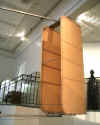WRIGHT BROTHERS
Aeroplane Company
A Closer Look



In
preparation for building of flying copy of the 1905 Wright Flyer 3 (see The
Wrights Fly Again), we took a trip to Carillon Park in Dayton, Ohio to
inspect the real McCoy -- the original 1905 aircraft, restored under the
supervision of Orville Wright. The aircraft is displayed in a specially designed
building, Wright Hall. As you walk in, the aircraft is slightly
below you in a huge well or "pit." The curatorial staff, Mary Mathews
and Jean Palarmo, kindly let us into the pit to take close-up photos of the
aircraft to help prepare a set of engineering drawings. This was no small favor,
since this aircraft has been dubbed an national treasure by an act of Congress
and several respected historians have called it one of the most valuable
artifacts in the history of technology.
It was an opportunity to get nose to
nose with the craftsmanship of the Wright brothers, marvel at their attention to
detail, and explore their innovative, no-nonsense approach to engineering. We
thought you might like to the share this adventure, so here, with many thanks to
Carillon Park, are some of the photos that we took of the 1905 Wright Flyer 3.

Let's begin with a walk around the plane. This is
what greets you when you enter Wright Hall. |

Move to your right and begin to walk around the pit.
The wooden box is the Wright's Huffman Prairie tool chest. |

If you could descend the stairs into the pit, here's
how the Flyer looks at eye level. |

Looking at the aircraft from the side -- this is
what Will and Orv saw when they ran beside it on take-off. |

Continuing around, here's a diagonal view from the
rear. |

Further along, you get a good overview of the
cockpit. |

Here's the Flyer from the rear, looking forward. |

Another diagonal view. We're almost back to
where we started. |

Down in the pit, here's what the cockpit looks like
up close. |

All the flight instruments are at Orville's right
elbow -- anemometer, stopwatch, fuel shut-off. |

A view of the engine from the front. There is no
muffler. |

At the rear of the engine is a flywheel and the
drive sprockets. |

The pilot hooks his toes over this foot rest. There
is no safety belt. |

A chain runs from the engine to each propeller. |

The chain runs over a large sprocket on the
propeller shaft. |

The propeller is bolted to the shaft. It's also
screwed from the back. |

To keep the props from splintering, the ends are
covered with canvas. |

Note that the chain guide tubes are bent where the
chain crosses over itself. |

The Wrights added "blinkers" to the canard
to keep the aircraft's nose up in a turn. |

The elevator control varies the camber of the canard
as you move it. |

The elevator frame is bolted to the front skid to
make the aircraft easy to disassemble. |

The strut fittings are actually hinges that allow
the wings to warp. |

When the control cables pass through pulleys, the
Wrights inserted a bit of chain. |

The rudder is attached to the flyer with just two long
beams and bracing wires. |


![]()
![]()